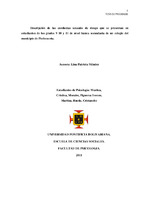| dc.contributor.advisor | Méndez Moreno, Lina Patricia | |
| dc.contributor.author | Morales Figueroa, Maritza Cristina | |
| dc.contributor.author | Rueda Cristancho, Ivonne | |
| dc.coverage.spatial | Seccional Bucaramanga. Universidad Pontificia Bolivariana. Escuela de Ciencias Sociales. Facultad de Psicología | spa |
| dc.coverage.temporal | 2011 | |
| dc.date.accessioned | 2014-09-09T20:07:03Z | |
| dc.date.available | 2014-09-09T20:07:03Z | |
| dc.date.created | 2011-09-08 | |
| dc.date.issued | 2014-09-09 | |
| dc.identifier.uri | http://hdl.handle.net/20.500.11912/1656 | |
| dc.description | 55p.: (pdf); tablas; anexos | spa |
| dc.description.abstract | La presente investigación tuvo como objetivo principal responder la pregunta ¿Cuáles son las principales conductas sexuales de riesgo identificadas en estudiantes de los grados 9 10 y 11 de nivel básica secundaria de un colegio del municipio de Piedecuesta? Tal estudio se realizó con criterios cuantitativo, transversal, descriptivo y no experimental. Con estos lineamientos, se evaluaron 585 menores escolarizados en edades entre los 14 a 18 años de edad, mediante la aplicación del Cuestionario Confidencial sobre Vida Sexual Activa (CCVSA), diseñado por el Ministerio de Salud de Colombia en 1997. El proceso se llevó a cabo en 4 fases: 1. Concertación con la institución, 2. Aplicación del instrumento, 3. Sistematización de la información, y 4. Análisis de datos para la discusión. Como consecuencia, los resultados obtenidos del análisis del programa SPSS. De la población evaluada, 158 menores respondieron tener vida sexual activa. Las conductas de riesgo más notorias fueron el no uso del preservativo en un 54.4% de los cuales el 25.9% mencionó no hacerlo por disgustarle su uso. Otra práctica de riesgo encontrada fue estar bajo los efectos del alcohol durante la relación sexual en un 33,5%. La responsabilidad que se cuestiona durante este periodo del ciclo vital se refleja en el hallazgo de tan sólo un 5,7% de la población que se había aplicado el ELISA. El dato con mayor frecuencia sobre el inicio de la vida sexual fue de un 38.8% a los 15 años. En definitiva la actual investigación buscó señalar con resultados científicamente comprobables, la importancia de una sana educación sexual y la prevención de conductas de riesgo en los adolescentes a nivel municipal, departamental y nacional, partiendo de hechos como las estadísticas reportadas por la Secretaría de Educación que expone diversos tipos de variables. | spa |
| dc.description.abstract | The research question of this study was What are the main risk sexual behaviors identified in students in grades 9 10 and 11 basic secondary level of a college Piedecuesta? The study is quantitative, cross-sectional, descriptive, not experimental, and to give the same development was evaluated at 585 school children with ages ranging from 14 to 18 years old, through confidential questionnaires regarding sexual activity (CCVSA), designed by the Ministry of Health of Colombia in 1997. The process was conducted through 4 stages: 1. Consultation with the institution, 2. Implementation of the instrument, 3.Systematization of information, 4. Data analysis for discussion. Thanks to the results obtained from the analysis of SPSS. Of the evaluated population, 158 minors responded to have active sexual life. The more well-known risk factors were the nonuse of the preservative in 54,4% of which the 25,9% mentioned a displeasure in the use of preservative. Another practice of found risk was to be under the effects of the alcohol during the sexual relation in a 33.5%. The responsibility that is questioned during this period of the vital cycle reflects in the finding of only a 5.7% of the population that had been applied the ELISA. The data most frequently on the beginning of the sexual life went of 38,8% to the 15 years. The present investigation really looked for to indicate with scientifically provable results, the importance of one heals to sexual education and the prevention of conducts of risk in the adolescents at municipal, departmental and national level, starting off of facts like the statistics reported by the Secretariat of Education that sets out diverse types of variables. | |
| dc.language.iso | es | |
| dc.publisher | Universidad Pontificia Bolivariana | spa |
| dc.rights | Attribution-NonCommercial-NoDerivatives 4.0 International | * |
| dc.rights.uri | http://creativecommons.org/licenses/by-nc-nd/4.0/ | * |
| dc.subject | Psicología | spa |
| dc.subject | Riesgo (Psicología) | spa |
| dc.subject | Piedecuesta (Santander, Colombia) | spa |
| dc.subject | Niños - Conducta sexual | spa |
| dc.subject | Sexo | spa |
| dc.subject | Estudiantes | spa |
| dc.subject | Sida | spa |
| dc.subject | Condones | spa |
| dc.subject | VIH | spa |
| dc.subject | Tesis y disertaciones académicas | spa |
| dc.title | Descripción de las conductas sexuales de riesgo que se presentan en estudiantes de los grados 9, 10 y 11 de nivel básica secundaria de un colegio del municipio de Piedecuesta | spa |
| dc.type | bacherlorThesis | spa |
| dc.rights.accessRights | openAccess | spa |
| dc.type.hasVersion | publishedVersion | spa |
| dc.identifier.instname | instname:Universidad Pontificia Bolivariana | spa |
| dc.identifier.reponame | reponame:Repositorio Institucional de la Universidad Pontificia Bolivariana | spa |
| dc.identifier.repourl | repourl:https://repository.unab.edu.co/ | |


